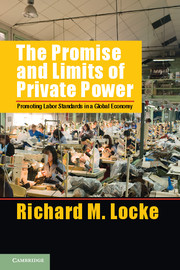Book contents
- Frontmatter
- Contents
- Acknowledgments
- 1 The Rise of Private Voluntary Regulation in a Global Economy
- 2 The Promise and Perils of Private Compliance Programs
- 3 Does Private Compliance Improve Labor Standards?
- 4 Capability Building and Its Limitations
- 5 Alternative Approaches to Capability Building
- 6 Are We Looking in The Wrong Place?
- 7 Complements or Substitutes?
- Conclusion
- Bibliography
- Index
- References
5 - Alternative Approaches to Capability Building
A Tale of Two Nike Suppliers
Published online by Cambridge University Press: 05 May 2013
- Frontmatter
- Contents
- Acknowledgments
- 1 The Rise of Private Voluntary Regulation in a Global Economy
- 2 The Promise and Perils of Private Compliance Programs
- 3 Does Private Compliance Improve Labor Standards?
- 4 Capability Building and Its Limitations
- 5 Alternative Approaches to Capability Building
- 6 Are We Looking in The Wrong Place?
- 7 Complements or Substitutes?
- Conclusion
- Bibliography
- Index
- References
Summary
What role can capability-building programs play in improving working conditions in global supply chains? Why do capability-building initiatives produce such mixed results among supply chain factories that implement them? How does this approach relate to other strategies and regulatory approaches aimed at promoting just working conditions in global supply chains? This chapter addresses these questions and explores both the potential and limitations of the capability-building model through a detailed matched pair case study of two factories supplying Nike, the world's largest athletic footwear and apparel company. These two factories have many similarities – both are in Mexico, both are in the apparel industry, both produce more or less the same products for Nike (and other brands), and both are subject to the same Code of Conduct. On the surface, both factories appear to have similar employment (i.e., recruitment, training, remuneration) practices, and they received comparable scores when audited by Nike's compliance staff. However, underlying (and somewhat obscured by) these apparent similarities, significant differences in actual labor conditions exist between these two factories. What drives these differences in working conditions? How do they relate to the different approaches to capability building deployed in these two factories? Field research conducted at these two factories reveals that beyond the introduction of new management systems and production techniques, workplace conditions, and labor standards are shaped by very different patterns of work organization and human resource management policies. Consistent with alternative approaches to capability building, some of these policies seek to give voice to and empower shop floor workers, whereas other policies aim to reduce worker voice and discretion. The consequences of these different approaches to capability building for workers and labor standards is significant and explains the variation we observed in the previous chapter.
Information
- Type
- Chapter
- Information
- The Promise and Limits of Private PowerPromoting Labor Standards in a Global Economy, pp. 105 - 125Publisher: Cambridge University PressPrint publication year: 2013
